Mark Sisson's Blog, page 115
February 18, 2019
We Want To Share Your Stories (and a Giveaway!)
 Success stories will be back in their regular slot next Monday, but for today I want to issue an invitation.
Success stories will be back in their regular slot next Monday, but for today I want to issue an invitation.
Now that we’ve turned the corner on the first month of the year, I know some of you have already seen big success with Primal or Primal-keto living. And I’d love to share your stories—to help inspire others here and to offer the kind of varied and personal accounts that only reader experiences can. Will you join the hundreds of others who have helped along the way?
Over the years I’ve heard time and again about folks finally taking the plunge because of a story that touched them personally. Maybe they had the information, knew the Primal laws, had read the blog for weeks or months even, but another reader’s account of their journey brought it all home for them. The difficulties that person started with and the amazing transformation that resulted—this was a story they were somehow meant to read. It was what reached them—and put them on their own path to renewed health, more vitality, and a better life.
The fact is, when you share your own story, you never know who you’ll be helping. And that’s an awesome thing.
I’ll add that it doesn’t matter if you’ve reached your ultimate goals yet or are still on your way. If you’re feeling better, eating better, moving better, sleeping better and just living better, that’s what inspires people. I bet there are a whole lot of folks hesitating on the sidelines wondering if they can do this who would love to hear from someone who hasn’t necessarily reached their goal but is on their way—someone who’s a month or two in who can show them that the beginning isn’t as hard as they fear it will be. And that the benefits come sooner than they dare imagine.
Likewise, if you’re someone who went Primal years ago (and even submitted an earlier success story) but continue to live a better life than you dreamed because of the changes you made long ago—we want to hear how you’ve stayed the course, what adjustments you’ve found helpful, what long-term lessons have surfaced over the years. There’s nothing quite like a great update.
So, let me offer an incentive to kick us off….
The Giveaway
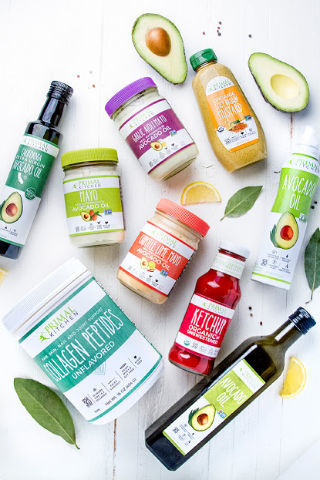 Anyone who sends me their success story along with photos will be entered to win a $200 gift certificate to Primal Kitchen®. That’s $200 of Primal bucks for all the Avocado Oil, Mayo, Condiments, Dressings, or Collagen you want—your choice.
Anyone who sends me their success story along with photos will be entered to win a $200 gift certificate to Primal Kitchen®. That’s $200 of Primal bucks for all the Avocado Oil, Mayo, Condiments, Dressings, or Collagen you want—your choice.
Want to try our new BBQ or Steak Sauces? Check. How about a full collection of Collagen or Protein Bars? Check. Prefer to stock up on Primal Fuel? Whatever your favorites, you got ’em.
I’ll also choose two additional submissions for a Primal library collection with some of our most popular titles: The Primal Connection, Primal Cravings, Paleo Cooking Bootcamp For Busy People, The Paleo Primer, and Primal Blueprint: Healthy Sauces and Dressings.
Anyone who submits a story will receive a 20% discount they can apply to any purchase from either PrimalKitchen.com or PrimalBlueprint.com.
I’m sure many of you have thought about sending your story in but just haven’t gotten around to it. There is no better time than now.
Write it up and include a few photos—the more the merrier, the bigger the better (since it’s easier to format for the site that way). Including both pre-Primal and post-Primal pics is even better, but isn’t required.
Don’t worry if you’re not a chiseled Adonis. This isn’t a “who’s the most ripped” competition. No matter where you’re at in your transformation, tell me what going Primal has done for you so far.
How To Do It
I’m looking for interesting and personal tales. Details about your health history, how you found MDA and the Primal Blueprint, what has worked and what hasn’t, what differences you’ve seen in how you look and feel, and anything else you think readers might be able to learn from and you’re open to sharing are welcome. It doesn’t have to be a 3000-word essay, but it’s hopefully more than a few paragraphs. Feel free to be creative with your story format, too. Still, remember, good stories usually have a beginning, a middle, and an end—and honesty is king.
Check out other Success Stories here for ideas on how to write your own story.
Email me your story along with pictures. Please use the subject heading “My Primal Story.” Otherwise, there’s a good chance we might miss your submission.
Eligibility:
Anyone in the world can enter.
Additionally, everyone who has submitted a Success Story to Mark’s Daily Apple in the past is free to submit an updated story and new photos.
The Deadline:
Friday, March 8, 2019, midnight PST
How the Winner Will Be Determined:
My staff and I determine which stories and accompanying photos get published on MDA. The winners of the giveaway will be chosen at random from those that are submitted by the deadline.
Thanks, everybody. I’m excited to read what you send—and to share it with our MDA audience. Have a great weekend.

The post We Want To Share Your Stories (and a Giveaway!) appeared first on Mark's Daily Apple.



February 15, 2019
Weekly Link Love—Edition 16

Research of the Week
Stimulating the vagus nerve helps PTSD.
Exercise has a stronger effect on cognitive function in older men than older women (who already had better function at baseline).
Estrogen controls type 2 diabetes.
Small teams of scientists disrupt ideas, larger teams develop ideas.
AIs are great at colluding.
If you have a family history of obesity, eat fish. Habitual intake of fatty fish limits genetically-associated weight gain.
Activated charcoal may protect your microbiome from antibiotics.
Mice who took nicotinamide riboside while nursing had smarter offspring.
To reduce liver fat, reduce ferritin. Neither red meat nor fiber have any effect.
New Primal Blueprint Podcasts

Episode 311: Drew Manning: Host Elle Russ chats with Drew Manning, best-selling author of Fit2Fat2Fit.

Episode 312: Keto: William Shewfelt: Power Ranger and Carnivore Shredder: Host Brad Kearns chats with William Shewfelt, who plays a Power Ranger on TV and a carnivore at meal-time.
Each week, select Mark’s Daily Apple blog posts are prepared as Primal Blueprint Podcasts. Need to catch up on reading, but don’t have the time? Prefer to listen to articles while on the go? Check out the new blog post podcasts below, and subscribe to the Primal Blueprint Podcast here so you never miss an episode.
Media, Schmedia
The FDA recommends approval of club drug ketamine for treating depression.
Interesting Blog Posts
Maybe insects aren’t quite disappearing.
Social Notes
I gave a talk on metabolic flexibility and the Keto Reset at Natural Grocers in Colorado late last year. Here’s the video.
I’ve been playing around on Twitter lately. It’s fun. Go follow me.
Everything Else
Exercise may not be the best way to lose weight in general, but it’s great against visceral fat.
Don’t lick your chickens, like the kid in the photo.
Things I’m Up to and Interested In
I’d watch this episode of Scooby Doo: Where the man dressed as a spooky stick of butter says, “And I would have induced autophagy too if it weren’t for you meddling trans-fatty acids!”
I’m not surprised: R0undup linked to non-Hodgkin’s lymphoma.
I am surprised: “This suggests that the majority of the lean mass lost with dieting may be the fat-free component of adipose tissue.”
Article I’m pondering: Should we play God, actually?
This is a powerful story: The first C-section.
Question I’m Asking
Read that Israeli Paradox post up above. What other paradoxes can you name?
Recipe Corner
Magic short ribs in the Instant Pot.
Pumpkin soup is legit.
Time Capsule
One year ago (Feb 10 – Feb 16)
The Definitive Guide to Chocolate – Guide to brown gold.
Primal Reflection Point: How Are You Playing?– Well, how are you?
Comment of the Week
“By the way, Mark, the title image for all of the Weekly Link Love posts kinda looks like you’re listening to some Fats Domino–in the middle of “doin’ the Twist!” Right?? [image error]”
– Beatles’ “Twist and Shout,” actually!

The post Weekly Link Love—Edition 16 appeared first on Mark's Daily Apple.



February 14, 2019
Keto Chicken Pot Pies
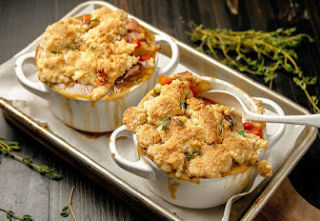 Pot pies—like sloppy joes—are a comfort food classic that feeds our nostalgia as well as appetite. Meat and veggies in a creamy sauce that’s topped with a crunchy topping…what’s not to love? It might seem, however, that pot pie isn’t compatible with a Primal, let alone keto, plan. Au contraire. We’ve serving up a recipe today that turns that assumption on its head. Pot pie is no longer pie in the sky for the keto eater. Enjoy!
Pot pies—like sloppy joes—are a comfort food classic that feeds our nostalgia as well as appetite. Meat and veggies in a creamy sauce that’s topped with a crunchy topping…what’s not to love? It might seem, however, that pot pie isn’t compatible with a Primal, let alone keto, plan. Au contraire. We’ve serving up a recipe today that turns that assumption on its head. Pot pie is no longer pie in the sky for the keto eater. Enjoy!
Time In the Kitchen: 40 minutes
Servings: 4
Ingredients:
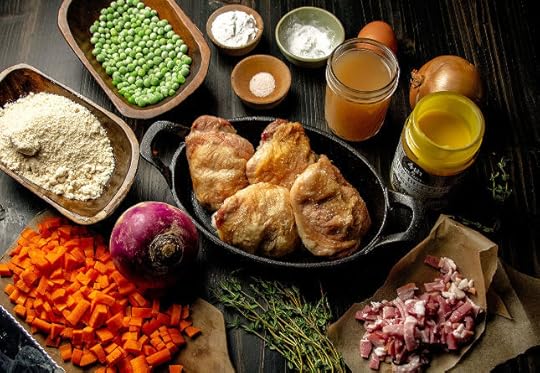
For the Filling
4 slices of bacon
1 white or yellow onion, chopped
7 ounces/200 grams pre-cooked chicken (meat from approximately 3-4 chicken thighs)
1 carrot cut into cubes
1/2 cup chopped turnip
2-3 cups chicken stock or bone broth
2 tbsp arrowroot flour
Instructions:
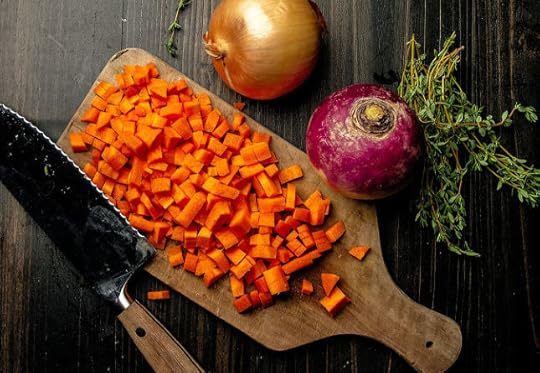
In a large pan with lid, saute the bacon and onion over medium heat.
Add in the carrots and mushrooms. Cook through.

Add in chicken and cover the mixture with chicken stock.
In a separate pot, stir arrowroot with a drizzle of cold water.
Add the flour mixture to the chicken, carrots and mushroom. Add frozen peas and thyme. Lower heat and cook until the sauce thickens.
Remove from heat and distribute evenly in oven-safe bowls or ramekins.
For the Crust
1 1/4 cup almond flour
1/4 tsp salt
1/2 tsp baking powder
1 egg
4 tbsp ghee
Instructions:
Preheat oven to 350 ºF/175 °C.
Mix all dry ingredients together.
Mix the egg and the ghee in a separate bowl.
Combine the dry and the wet ingredients together. The dough should be moist like the dough for drop biscuits.
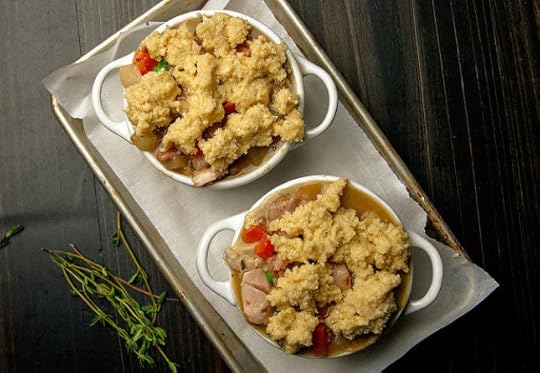
Spread the dough evenly on the ramekins filled with the chicken and vegetable filling.
Bake in the oven for 20-25 minutes until the crust is golden. Put under broiler for a very short time to brown the crust at the end if desired.
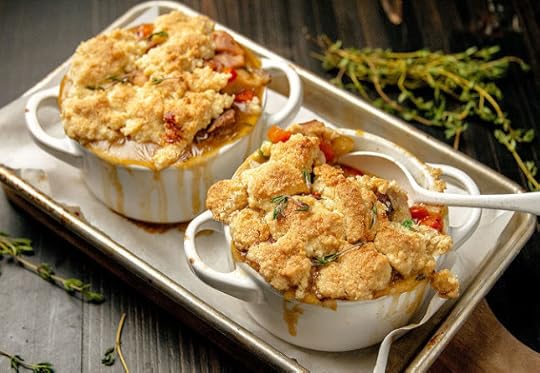
Nutritional Information
Calories: 534
Carbs: 14.75 grams
Fat: 39 grams
Protein: 29 grams
The post Keto Chicken Pot Pies appeared first on Mark's Daily Apple.



February 13, 2019
Is Keto Bad For Cholesterol?
 We’ve all heard the story. Maybe we’ve even been the protagonist.
We’ve all heard the story. Maybe we’ve even been the protagonist.
Person goes full keto. They lose a bunch of weight, normalize their pre-diabetic glucose numbers, resolve their high blood pressure readings, have more energy, feel great, and have nothing but high praise for the new way of eating.
Except for one thing, everything seems perfect: their cholesterol is sky-high. It throws a wrench into the whole operation, installs a raincloud over the procession, spoils their confidence.
“Could I be killing myself?”
“Are my health improvements just a mirage?”
In other words, are the apparent benefits of keto merely superficial if your cholesterol skyrockets?
The evidence is pretty clear that for the majority of adults who go keto, their cholesterol numbers improve.
In obese adults with type 2 diabetes, a ketogenic diet improved blood lipids and boosted fat loss compared to a low-calorie diet.
In lean, healthy adults without any weight to lose (and who didn’t lose any weight during the course of the diet), total cholesterol went up from 159 to 208 mg/dL and triglycerides fell from 107 to 79 mg/dL. A lipophobic doc might freak out at the rise in TC, but given that the triglycerides dropped, I bet the change reflects a rise in HDL and an overall positive, at worst-neutral effect.
Another study of lean adults with normal cholesterol numbers found that going keto improved their lipids, reducing triglycerides, increasing HDL, and leaving LDL unchanged. Those with small pattern B LDL particles (the “bad kind”) saw their LDL particle size increase, on average. All told, keto was beneficial.
But you aren’t everyone. You aren’t the average of a population. And, given the number of readers I have and the number of people trying a ketogenic diet, there are bound to be some people whose lipid profiles go in the other direction.
I don’t give medical advice here, and I always encourage people to partner with the physicians for health solutions. That said, let me share some thoughts on the keto-cholesterol question….
I’m not just talking about high total cholesterol or high LDL-C. I’m talking about what appears to be the real, legit risk factor for a cardiac event: elevated LDL particle number. According to experts like Dr. Peter Attia and Dr. Chris Masterjohn, atherosclerosis occurs when LDL particles infiltrate the endothelial lining of our arteries. Thus, it’s not high LDL cholesterol that increases the risk of atherosclerosis—LDL-C is the cholesterol found inside the particles— it’s a high number of LDL particles in circulation. The more LDL-P, the greater the chance of them becoming oxidized and infiltrating the arterial wall. There are many factors to consider, like oxidative stress, inflammation, and fatty acid composition of the LDL particles, but all else being equal, a greater number of LDL particles seems to increase the risk of a heart attack.
What Could Be Causing LDL Elevations On Keto?
Weight Loss
I asked Dr. Cate Shanahan for her input on this topic, and she provided a beautiful explanation:
But when you stop eating so many carbs insulin politely steps aside, and your insulin levels plummet. Now your body fat can more easily and more often release its stores of fatty acids into your bloodstream.
When your body fat releases stored fatty acids, any unused fatty acids quickly get picked up by the liver and packed into VLDL lipoprotein. VLDL is a precursor to LDL. So in reducing your insulin levels and increasing your body’s use of fat, you will raise your VLDL, LDL and total cholesterol. You are simply trafficking in fat more often now. And now, because your body stabilizes fat carrying lipoproteins with cholesterol, there is a need for more cholesterol in your blood. These are not bad consequences. They are in fact happy signs your diet is doing what its supposed to be doing.
If you’re actively losing weight, you will probably experience a rise in cholesterol. This is the transient hypercholesterolemia of major weight loss, and it’s a well-known phenomenon. Once your weight stabilizes, cholesterol should normalize—although to a lesser extent than other diets, given Dr. Cate Shanahan’s explanation of increased “trafficking in fat.”
Low Thyroid Function
The thyroid is a barometer for your energy status. If you have plentiful energy to spare, thyroid function is normal. If your body perceives low energy availability, thyroid function may down-regulate. Since the thyroid plays a big role in regulation of LDL receptor activity, its downregulation can lower LDL receptor sites. Fewer LDL-receptors clear LDL particles from the blood. Folks with genetic predispositions to heart disease often have low LDL receptor activity, causing elevated LDL particles. Folks with genetic variants that increase the activity and expression of LDL receptors have lower heart disease rates. Although genes often have different effects that may affect disease risk via other pathways, that’s pretty strong evidence that LDL receptor activity regulates, at least in part, one’s LDL-P and heart disease risk.
Read this post for maintaining thyroid function on keto, and check out Elle Russ’ Paleo Thyroid Solution for an even deeper, more thorough dive into thyroid health.
Eating Too Damn Much
Some keto people pride themselves on gorging. Some are doing it for a good cause—a quest to find the fabled metabolic advantage. Some are doing it to show off and for keto cred—look how much salami I can eat! Some are using keto to deal with unresolved issues with food itself.
Everything I say about doing keto presupposes that you are eating like a normal person. You’re eating as much as you need to fuel your brain and daily activities, fitness and performance goals. You’re leaving the table satiated, not stuffed. For most people, this happens without even trying. It’s why keto is so effective for weight loss.
Genetic Variance
Genes aren’t destiny, but they do modify and regulate our response to a given environmental input.
Some people are dietary cholesterol hyper responders. Unlike the majority of the population, they absorb tons of dietary cholesterol and do not down-regulate their endogenous production to accommodate. The result is an increase in cholesterol synthesis and absorption, leading to a spike in blood cholesterol.
Some people are sensitive to saturated fat. In response to it, they produce elevated numbers of LDL particles. If your keto diet is high in saturated fat and you have a genetic sensitivity to it, your cholesterol will probably skyrocket.
Some people have genes that reduce the activity of their LDL receptors. This will necessarily boost LDL particle numbers.
This topic—genetic variance and how it affects keto—could be an entirely separate post, so I’ll leave it at that (and probably come back to it in the future).
Too Much Butter
Huh? Too much butter, Sisson? Is such a thing even possible?
Maybe. Subjecting cream to the butter-making process strips it of something called milk fat globule membrane (MFGM). And when you compare equal amounts of dairy fat through either cream (with MFGM intact) or butter oil (with MFGM absent), you get very different metabolic effects. Those who ate 40 grams of dairy fat through butter oil saw their lipids worsen, including ApoB, a surrogate for LDL particle number. Those who ate 40 grams of dairy fat through cream saw their lipids unchanged, and in the case of ApoB even improve. That’s 4 tablespoons of butter compared to 4 ounces, or a half cup, of heavy cream.
Caveats apply here. The subjects weren’t eating a low-carb or ketogenic diet; they just added the butter or cream on top of their normal diet. But in keto people who are genetically susceptible, huge amounts of butter may be responsible for rising LDL-P.
I still love butter. It doesn’t affect my lipids like that. But your mileage may vary, and it’s something to think about if you’re in that situation.
For what it’s worth, whole food dairy like full-fat yogurt, kefir, and cheese do not have the same effect on lipids as butter. They also happen to be keto-friendly and more nutrient-dense.
So, What Can You Do If You See An Increase in LDL?
Start Chugging Soybean Oil
Kidding… It’s true that swapping out some of your animal fats for polyunsaturated seed oils will almost certainly lower your cholesterol levels. It does this by increasing LDL receptor activity, but, being far more unstable than other fats, omega-6 PUFAs also increase the tendency of the LDL particles to oxidize. And since oxidized LDL are the ones that end up wedging in the arterial walls and causing issues, loading up on PUFAs might not be the right path.
You know what just occurred to me? This is an aside, but maybe linoleic acid (the primary fatty acid in seed oils) up-regulates LDL-R activity because the body recognizes the inherent instability of linoleic acid-enriched LDL particles and wants to clear them out before they can cause trouble. I hope some researchers take this idea further.
Stop Being a Keto Caricature.
Half a package of cream cheese for a snack.
Dipping an entire stick of pepperoni into homemade alfredo sauce and calling it dinner.
I’m not saying cream cheese is bad. It’s great. Nor am I suggesting you never eat pepperoni, dipped in alfredo sauce or not. But the amounts are unreasonable. And turning those into regular meals is a bad idea. There’s no reason you can’t go keto while eating a hamburger patty or ribeye over a Big Ass Salad. Far more nutrients, far more micronutrients, and it tastes way better.
Eat Less
Maybe if you’re a nomadic horselord sweeping across Europe in the early Bronze Age, you need to eat an entire lamb intestine stuffed with marrow and organs, and you should wash it down with a quart of creamy mare milk. Such a meal would provide the calories you need to see your enemies driven before you and go great with the lamentations of their women. But you’re not a Yamnaya nomad. You’re you.
You probably don’t need that much food, that many calories, and that much fat—since there’s plenty of it on your body already, waiting to be liberated and converted into energy. Therein lies the beauty of keto. That’s what this is all about: Getting better at burning your own body fat.
Balance Your Fats
The overzealous and protracted drive to demonize all sources of saturated fat as evil has led to a vociferous backlash from the other direction. But just because the supposed experts got the saturated fat issue wrong doesn’t mean the opposite is true: That all the fat we eat should be as saturated as possible.
For one thing, eating nothing but saturated fat is very hard to do using whole foods. Very few animals exist in the world, past or present, with only saturated fat. The only exception I can recall is the coconut, a curious sort of beast that spends most of its time hanging from a tree impersonating a large hairy drupe. Your average slab of beef fat runs about 50% saturated fat, 45% monounsaturated fat, and 5% PUFA. That differs from cut to cut and depending on the diet of the animal, but not by much. It’s similar for other ruminants like bison and lamb. And the most prominent saturated fatty acid in ruminant fat is stearic acid, a fat that converts to monounsaturated oleic acid in the body and has an effect on cholesterol indistinguishable from MUFA or PUFA.
Or take the fatty acid composition of game meat—the type humans encountered and consumed for our entire history.
African kudu (antelope family): 35% SFA, 24% MUFA, 39% PUFA
African impala (antelope family): 51% SFA, 15% MUFA, 33% PUFA
Elk: roughly 40% SFA, 30% MUFA, 30% PUFA
Moose: roughly 33% SFA, 33% MUFA, 33% PUFA
I could go on, but you get the idea: Humans have been consuming a wide range of fatty acids for millennia. It probably makes sense to emulate that intake.
Once again, the folks whose cholesterol goes nuts on keto are outnumbered by those whose cholesterol improves. But if you’re one of the unlucky ones in the former category, try broadening your fatty acid intake (to, ahem, possibly include more nuts):
Focus on monounsaturated fats and fat from meat, rather than isolated sources of saturated fat like butter and coconut oil. You probably don’t have to eliminate those fats. Just don’t make them the centerpiece of your diet.
Eat more avocados, avocado oil, olives, olive oil, and mac nuts for monounsaturated fat. Salads are a great nutrient-dense way to incorporate high-MUFA foods.
Eat more fish. A couple portions of farmed Atlantic salmon were enough to improve LDL-P in overweight men and women. And compared to plain keto, keto + omega-3s from fish has a superior effect on inflammation and metabolic health.
Eat more kudu and impala (if you can get it). Sort of kidding. But really, eat them if you can.
They even have a version of keto called the Spanish ketogenic diet, which features a lot of extra virgin olive oil, olives, fish, and red wine. It works great and might be a good alternative for people whose cholesterol goes wild on saturated fat-heavy keto.
Are Traditional Lipid Markers Even Relevant for Keto Dieters?
Maybe, maybe not.
But be honest about it. You can’t oscillate between championing positive changes to blood lipids on a keto diet and pooh-poohing negative changes to blood lipids on a keto diet.
You can’t use positive changes to prove the efficacy and safety of the ketogenic diet, then turn around and claim that negative changes don’t count because keto dieters are understudied. What if those “positive” changes are actually negative in the context of a ketogenic metabolism? After all, keto dieters are largely understudied in both directions. If what’s unhealthy in a normal dieter might be healthy in a keto dieter, what’s healthy in a normal dieter may be unhealthy in a keto dieter.
I write these things as a strong proponent of spending a significant time in ketosis. As someone who frequently hangs out in a ketogenic state. As someone who wrote a book about keto and is writing another. But also as someone who insists on maintaining strict intellectual honesty and integrity.
We simply don’t know what very high cholesterol numbers mean in the subset of ketogenic dieters who experience them. I strongly suggest not being too flippant about them.
True: There aren’t any perfect studies examining the utility of conventional cardiovascular risk factors in people eating the type of keto diets you see in the ancestral health space. Maybe your elevated LDL particle number doesn’t mean what it means in the average overweight adult eating the Standard American Diet. Maybe your inflammation is low enough that the risk of atherosclerosis and oxidative modification of LDL is low. But I wouldn’t take that risk, not until we have more data.
What do you think, folks? How did keto affect your blood lipids? Did you make any changes, and if so, did they work? Thanks for stopping in today.

Note: This information isn’t intended as and shouldn’t be considered medical advice. Always consult your doctor in the management or treatment of any health issue.
References:
Hussain TA, Mathew TC, Dashti AA, Asfar S, Al-zaid N, Dashti HM. Effect of low-calorie versus low-carbohydrate ketogenic diet in type 2 diabetes. Nutrition. 2012;28(10):1016-21.
Phinney SD, Tang AB, Waggoner CR, Tezanos-pinto RG, Davis PA. The transient hypercholesterolemia of major weight loss. Am J Clin Nutr. 1991;53(6):1404-10.
Phinney SD, Bistrian BR, Wolfe RR, Blackburn GL. The human metabolic response to chronic ketosis without caloric restriction: physical and biochemical adaptation. Metab Clin Exp. 1983;32(8):757-68.
Kleinveld HA, Naber AH, Stalenhoef AF, Demacker PN. Oxidation resistance, oxidation rate, and extent of oxidation of human low-density lipoprotein depend on the ratio of oleic acid content to linoleic acid content: studies in vitamin E deficient subjects. Free Radic Biol Med. 1993;15(3):273-80.
Rosqvist F, Smedman A, Lindmark-månsson H, et al. Potential role of milk fat globule membrane in modulating plasma lipoproteins, gene expression, and cholesterol metabolism in humans: a randomized study. Am J Clin Nutr. 2015;102(1):20-30.
Raatz SK, Johnson LK, Rosenberger TA, Picklo MJ. Twice weekly intake of farmed Atlantic salmon (Salmo salar) positively influences lipoprotein concentration and particle size in overweight men and women. Nutr Res. 2016;36(9):899-906.
De luis D, Domingo JC, Izaola O, Casanueva FF, Bellido D, Sajoux I. Effect of DHA supplementation in a very low-calorie ketogenic diet in the treatment of obesity: a randomized clinical trial. Endocrine. 2016;54(1):111-122.
Pérez-guisado J, Muñoz-serrano A. A pilot study of the Spanish Ketogenic Mediterranean Diet: an effective therapy for the metabolic syndrome. J Med Food. 2011;14(7-8):681-7.
The post Is Keto Bad For Cholesterol? appeared first on Mark's Daily Apple.



February 12, 2019
How to Accelerate Weight Loss with Fasting
 Folks, you know I’m a believer in intermittent fasting for longevity, autophagy, mental clarity, fitness performance, metabolic health, and more. So, when I heard that Dr. Jason Fung, a world expert on fasting, and his team at Pique Tea were putting together a Fasting Tea Challenge this month, I wanted to know more. And I think you will, too. You can check out the details and sign up here. (There’s more info and the sign-up link at the bottom of post, too.)
Folks, you know I’m a believer in intermittent fasting for longevity, autophagy, mental clarity, fitness performance, metabolic health, and more. So, when I heard that Dr. Jason Fung, a world expert on fasting, and his team at Pique Tea were putting together a Fasting Tea Challenge this month, I wanted to know more. And I think you will, too. You can check out the details and sign up here. (There’s more info and the sign-up link at the bottom of post, too.)
The Challenge looks to be a great experience for anyone interested in intermittent fasting—including those trying it for the first time and those who have done it before but want to make it more of a regular tool in their healthy lifestyle routine. I’m also thrilled that Dr. Jason Fung has stopped by the blog today to share a bit about fasting for weight loss. Enjoy—and be sure to share any questions you have on the comment board.
Over the years, I’ve shared with you the many ways intermittent fasting can benefit your health. So, it shouldn’t be much of a surprise that fasting can also be really beneficial to those who are trying to lose fat. Yes, I said fat and not weight. Unlike some other kinds of weight loss methods, which result in loss of water weight or muscle mass, fasting can effectively get rid of fat.
How Fasting Works
There’s a reason intermittent fasting has become so popular. For one, it’s more of a schedule than a diet, which means it’s endlessly customizable. There are a few different types of fasting (covered below), as well as a variety of schedules you can follow. It’s up to you to decide how to make it best fit your lifestyle. (1)
Alternate-Day Fasting
As the name suggests, this method involves eating every other day. On those days, you eat without restriction. On days that involve fasting, you can eat one small meal that provides about 25% of your daily caloric needs. This works great for people who don’t want to face an entire day without eating anything.
Whole-Day Fasting
Similar to alternate-day fasting, whole-day fasting means you fast 1-2 days per week. You can do a complete fast, with no calories at all, or one small meal that makes up about 25% of your daily caloric intake. A favorite way to do a 24-hr fast is to finish eating at 6 p.m. one day and then not eat until dinner at 6 p.m. the next day. Boom, 24 hours fasted but not a day went by without food.
Time-Restricted Feeding
This method allows a specific time frame during the day during which you can eat regular meals and snacks. A window of 8 a.m. to 3 p.m. is one example of when you can eat, or 12 p.m. to 7 p.m is another. This window of time is usually about 7 or 8 hours long. The rest of the time, you fast.
How Fasting Accelerates Fat Loss
Intermittent fasting almost invariably produces a calorie deficit, but it also creates ideal circumstances for fat burning—because it increases your insulin sensitivity. When you fast, your insulin levels drop, which makes it easier for your body to access your stored fat. That’s how your body opts to use fat for energy, instead of muscle. (2)
You might be familiar with this concept, because it’s the same reason why people adopt low-carb diets to shed fat. Eating low-carb will indeed lower your insulin levels, but the fact is that fasting will drop them even lower. This makes fasting more powerful for fat loss.
Another way fasting boosts fat loss is by increasing the amount of growth hormone (GH) your body produces. Studies have shown that production of GH can decrease your amount of body fat. (3, 4)
Finally, fasting has also been shown to increase production of norepinephrine—the fat burning hormone. The only catch? The study that showed this result was done on mice. Science hasn’t determined yet if it’s also the case with humans.
5 Tips to Accelerate Your Fasting
Intermittent fasting works best if you tailor it to your lifestyle, but there are a few rules you should follow. Here are my top 5 tips to accelerate your fasting for maximum fat loss:
1. Be Smart During Your Eating Window
When you start fasting, it’s easy to just focus on the not-eating part and trick yourself into thinking you can eat anything during your eating window. But if you want to jump-start fat loss, your meals should still be nutritious and healthy. Think no refined carbs, sugar, or processed food. Sticking to a healthy diet is also going to help make the fasting experience easier for your body.
2. Break Your Fast Properly
When you break your fast, it’s very important that you resist the urge to overeat. Over-indulging really defeats the purpose of that calorie deficit you created during the fast. Plus, it can be really uncomfortable for your digestive system and cause a stomach ache or other digestive distress. Try breaking your fast with a small salad or some nuts and then just eat normally.
3. Stay Active & Do Shorter Bursts of Intense Exercise
Don’t fall victim to a mindset that says you should lie around on the couch all day while fasting. It’s perfectly safe (and beneficial) to exercise. Follow your normal routine of walking and other means of slow and steady movement throughout the day. What you might want to skip, however, are long stretches of cardio work that can wear you down (particularly if you’re new to fasting). For intensive exercise while fasting—especially if you want to kick-start fat loss, HIIT is the way to go. You only need 10-15 minutes of high intensity interval training to stimulate fat burn in your body. Above all, work out when you have time and feel comfortable doing it, but you can also consider incorporating your interval training at the end of your fasting window—right before you’re about to break your fast.
4. Use Apple Cider Vinegar
The acetic acid in ACV helps keep your insulin levels low, which means you’ll enter a fat-burning state sooner. There’s also research indicating that ACV can boost ketosis by helping your cells produce more energy when you’re in that state. (5, 6) What that means for you is increased energy and mental clarity to stick with your fasting for longer. Try diluting 1-2tbsp of ACV in a glass of water and drinking it before your meals.
5. Use Green Tea
The number one reason people fail at fasting is because they give in to cravings. So, if you want to succeed at using fasting for fat loss, you need a plan for facing down those cravings. The number one doctor-approved natural way to beat cravings? Tea. Intermittent fasting and tea are a powerful combination for accelerating your weight loss.
Green tea especially has the ability to help regulate ghrelin, which is your hunger hormone, so you can finally gain back control of your appetite. It also boosts thermogenesis, which is the rate at which you burn calories, and it has the ability to enhance autophagy, your natural cellular renewal process.
Thanks again to Dr. Jason Fung for today’s post. Be sure to check out his 28-Day Fasting Tea Challenge. It’s a 28-day, guided experience that follows a 16/8 intermittent fasting schedule. Along the way, you’ll learn how tea can help you stay fasted longer and more comfortably. Pique Tea offers two Fasting Teas that are potent blends of the highest-quality green teas and other plants and herbs designed to suppress appetite, boost calorie burn, and improve digestion. The Fasting Challenge will also include three Facebook Live check-ins with Dr. Jason Fung, support from an in-house health coach, as well as practical tips to help you succeed at fasting.
Thanks for stopping by today, everybody. Have a great week.
References:
1. https://www.hsph.harvard.edu/nutritio...
2. https://www.ncbi.nlm.nih.gov/pubmed/1...
3. https://www.ncbi.nlm.nih.gov/pubmed/1...
4. https://www.ncbi.nlm.nih.gov/pubmed/2...
5. https://www.ncbi.nlm.nih.gov/pubmed/2...
6. https://www.ncbi.nlm.nih.gov/pubmed/2...

The post How to Accelerate Weight Loss with Fasting appeared first on Mark's Daily Apple.



February 11, 2019
The First 90 Days Have Given Me Confidence That I Can Do This—and More!
It’s Monday, everyone! And that means another Primal Blueprint Real Life Story from a Mark’s Daily Apple reader. If you have your own success story and would like to share it with me and the Mark’s Daily Apple community please contact me here. I’ll continue to publish these each Monday as long as they keep coming in. Thank you for reading!
 When did I first see it? It was in November 2017. I stepped on my scale and proceeded to log my information into my fitness tracker and there it was staring back at me. The tracker already knows my age and height and it spit out a calculation that never really caught my attention before. Under the heading for BMI (Body Mass Index) the word Overweight was highlighted with a color meant to get my attention. It did.
When did I first see it? It was in November 2017. I stepped on my scale and proceeded to log my information into my fitness tracker and there it was staring back at me. The tracker already knows my age and height and it spit out a calculation that never really caught my attention before. Under the heading for BMI (Body Mass Index) the word Overweight was highlighted with a color meant to get my attention. It did.
I’ve never had what you would call a weight problem. In fact at first glance most people would call me tall (at 6’2″) and skinny. But with a BMI at 25.8% I now was in the “overweight” bucket. I realize that a BMI calculation that is done this way doesn’t factor in a lot of things and someone that is muscular will have a higher BMI and that shouldn’t be a good indicator of a healthy weight. But that’s not me, I don’t have a muscular build so that excuse doesn’t hold water. The fact was that I let my weight and body fat creep up, I had let myself go. Most importantly, when I looked at my naked self in the mirror I wasn’t happy with what was there and wanted to change.
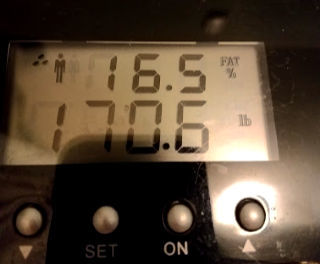 Now I had already loosely followed Mark’s Daily Apple and was very well aware of the new Keto Reset Diet book that had recently been released and caught my attention. So I made a quick decision to order the book and get ready to start my reset experiment before the big holiday season. My goal was to begin November 1 2017 and go through until at least the new year. Most importantly tracking my body fat percentage and along with it my weight of course.
Now I had already loosely followed Mark’s Daily Apple and was very well aware of the new Keto Reset Diet book that had recently been released and caught my attention. So I made a quick decision to order the book and get ready to start my reset experiment before the big holiday season. My goal was to begin November 1 2017 and go through until at least the new year. Most importantly tracking my body fat percentage and along with it my weight of course.
I did just that, and here are my results. (These body fat and weight details are from my home scale so they are not exact figures, but they show my steady and consistent downward track overall.) These results DID NOT include a new workout routine. In fact I did no exercise program at all for the first 45 days then started to add in 20-40 minute fast walks 3-4 days a week in mid December which I continue to this day.
Started 11/1/2017 – 24.2% fat / Weight 201.2 lbs / 25.8 BMI
12/1/2017 – 19.0% fat / Weight 183.6 lbs / 23.6 BMI (Month totals -5.2% fat / -17.6 lbs)
1/1/2018 – 19.6% fat / Weight 177.4 lbs / 22.8 BMI (Month totals +0.6% fat / -6.2 lbs)
2/1/2018 – 16.5% fat / Weight 170.6 lbs / 21.9 BMI (Month totals -3.1% fat / -6.8 lbs)
In those 3 months I reduced my body fat by 7.7%. My weight reduced by 30.6 lbs. And my BMI now set comfortably in the “normal” category going from 25.8 down to 21.9.
Was it easy? Yes and No.
The plan itself was easy and I had no problem with the transition and knowing what I should and shouldn’t be doing to get the results I wanted.
The hard part was keeping myself on track during those holiday gatherings filled with sugary treats and that bachelor party weekend of booze and more treats. Was I perfect? Far from it! But I made a lot of good choices too. When I did allow myself to “cheat” I did it in moderation. For example, I did have a piece of my mom’s pecan pie on Thanksgiving, but it was a small piece and I passed on the ice cream. During the bachelor party weekend I drank more alcohol than I should have (go figure) but I tried to stay away from the beer and kept it at straight liquor and some wine.
I continue on this journey with a desire to keep reducing my body fat percentage. The first 90 days of success have given me confidence that I can do this and more. I am now going to add in some resistance training and see what kind of muscle I can add to this 48-year-old body. Something I’ve never been able to achieve in my life. The Keto Reset Diet book gave me the tools to take better control of my body and overall health.
As of the writing of this, Valentine’s Day 2018, I am at 16.1% fat, weight 169.8 lbs with a 21.8 BMI.
I also have additional health benefit that should be more than a side note here. I ordered a lipid test when I completed my first 90 days just to see how this new routine may have affected my overall health. My triglycerides as of 2/2/18 were at 64 with a HDL/Tri ratio of 1.08. The most recent test before that was 10/18/2014 and I was at 168 for my triglycerides and my HDL/Tri ratio was 3.7. What a huge improvement, a drop of 104 for my triglycerides! I wish I had a closer baseline test, but I know very little changed for me in my diet and actively since that previous test, if anything it got worse. I doubt my numbers were any better when I started this just over 3 months ago but I’m very happy with where I am now.
Thanks for everything you provide Mark (and Brad)! It’s been life changing for me.


The readers featured in our success stories share their experiences in their own words. The Primal Blueprint and Keto Reset diets are not intended as medical intervention or diagnosis. Nor are they replacements for working with a qualified healthcare practitioner. It’s important to speak with your doctor before beginning any new dietary or lifestyle program, and please consult your physician before making any changes to medication or treatment protocols. Each individual’s results may vary.
The post The First 90 Days Have Given Me Confidence That I Can Do This—and More! appeared first on Mark's Daily Apple.



February 8, 2019
Weekly Link Love—Edition 15

Research of the Week
Adults sleep better and retain more memories in a bed that rocks.
Some human adaptations to extreme environments.
A new gene editing technology—CasX—emerges.
Post-workout carbohydrate replacement reduces the next-day benefits to insulin sensitivity and glucose tolerance.
Kids with fatty liver improve it by dropping sugar.
How a specific ketone body inhibits hypertension.
In Americans, intense experiences predict good health. In Japanese, relaxing experiences predict good health.
New Primal Blueprint Podcasts

Episode 309: Jennilyn Griffiths: Host Elle Russ chats with Jennilyn Griffiths about the upcoming FitCon Summit.

Episode 310: Sharon Brown: Host Brad Kearns chats with Sharon Brown, the founder and CEO of Bonafide Provisions, which makes the number one selling frozen bone broth in the country.
Each week, select Mark’s Daily Apple blog posts are prepared as Primal Blueprint Podcasts. Need to catch up on reading, but don’t have the time? Prefer to listen to articles while on the go? Check out the new blog post podcasts below, and subscribe to the Primal Blueprint Podcast here so you never miss an episode.
Media, Schmedia
Erwan Le Corre on the limitations of the gym.
Coca-Cola had (has?) plants in the CDC.
Interesting Blog Posts
Dr. Mike Eades takes on the Framingham Heart Study.
Social Notes
My answer to “Is there an optimal diet for each person?”
Isn’t it pretty (plus a contest)?
Everything Else
Imagine taking one of these with a spear.
Aren’t avocados just the best?
Parkinson’s is set to skyrocket.
Things I’m Up to and Interested In
Argument for GMO skepticism I found compelling: That making precise, controlled changes to microscopic properties can result in imprecise, uncontrolled macroscopic changes to outcome.
Photos I loved: The ones of trident-wielding surfers riding Lake Superior waves during the polar vortex.
Old article I enjoyed: They Thrive on All-Meat Diet (from Maclean’s in 1929).
Phrase I’m digging: “Inside-bone nutrients.”
This makes sense: The wilder the nature, the more benefits.
Question I’m Asking
Where do you prefer to train—in the gym or in the natural world? How do you prefer to train—using varied dynamic real world movements or with weights and machines?
Recipe Corner
Paleo curried meat pies. Low-carb? No, but certainly paleo.
Stuffed and wrapped chicken thighs.
Time Capsule
One year ago (Feb 3 – Feb 9)
8 Herbs and Spices You Aren’t (Likely) Using—and Should – What to sprinkle on your dishes.
Keto and Type 2 Diabetes – How keto and Type 2 diabetes interact.
Comment of the Week
“Workstation? I’ve been in outside sales for 20 years now. I have a folding keyboard. Short work can be using it on top of my shoulder bag. Or even on top of a payphone that no one will ever use again.”
– I enjoy the image of James Bond clacking away on his laptop on an abandoned payphone, Roger Moore.
Want to make fat loss easier?
Try the Definitive Guide for Troubleshooting Weight Loss for free here.
The post Weekly Link Love—Edition 15 appeared first on Mark's Daily Apple.



February 7, 2019
Wedge Salad With Blue-Cheese Ranch Dressing
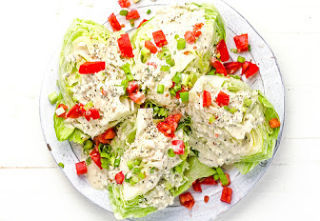 Salads can be as Big-Ass or as simple as mood and time dictate, but they always should be flavorful. We love this classic (and keto-friendly) recipe for a quick side or (topped with some bacon crumbles) a light lunch or dinner. The best part…it’s made with staple ingredients that are easy to keep on hand.
Salads can be as Big-Ass or as simple as mood and time dictate, but they always should be flavorful. We love this classic (and keto-friendly) recipe for a quick side or (topped with some bacon crumbles) a light lunch or dinner. The best part…it’s made with staple ingredients that are easy to keep on hand.
Bright, colorful, crisp and rich, it’s a great choice for a midweek family supper or even an impromptu dinner party.
Servings: 4
Time In the Kitchen: 5 minutes
Ingredients:

1 head iceberg lettuce, cut into 4 wedges
2 roma tomatoes, diced
2 stalks green onions, white and light green parts diced
¼ cup crumbled blue cheese
1 cup Primal Kitchen® Ranch Dressing
1–2 tablespoons Primal Kitchen Mayo, optional
Instructions:
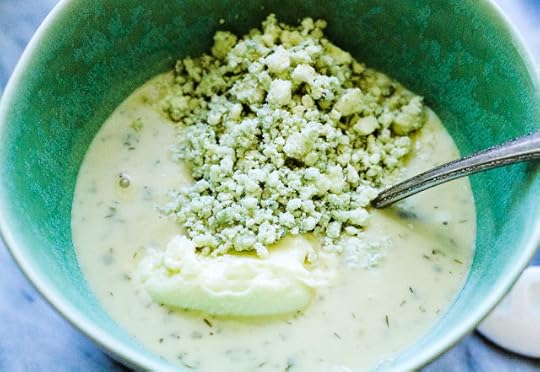
In a small mixing bowl, combine about 1 cup of Primal Kitchen Ranch Dressing with blue cheese. If you’d like a thicker dressing, add 1–2 tablespoons Primal Kitchen Mayo. Mix well and refrigerate.
Place iceberg wedges on 4 plates. Sprinkle evenly with tomatoes and green onions. Drizzle with blue-cheese ranch dressing.
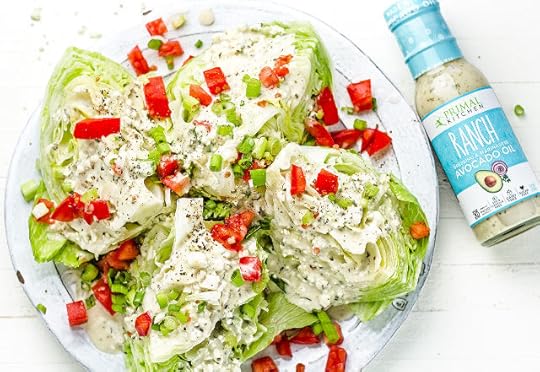
Nutritional Information (without mayo):
Calories: 388
Net Carbs: 12 grams
Fat: 35 grams
Protein: 6 grams

The post Wedge Salad With Blue-Cheese Ranch Dressing appeared first on Mark's Daily Apple.



February 6, 2019
Can I Eat Fruit On a Keto Diet?
 Question: “Can I eat fruit on a ketogenic diet?”
Question: “Can I eat fruit on a ketogenic diet?”
Answer: “Sure, if you want!”
I’m kidding, of course. I know why people ask this question. It’s because in the keto world fruit is a confusing, often contentious topic. You’ll sometimes see keto folks draw a hard line in the sand, saying that all fruits, or sometimes specific fruits, are “not allowed” on a ketogenic diet. I’ve written before about why I feel it’s inappropriate to label foods as “keto” or “not keto.” People need to consider their own goals, health, activity level, and food preferences when formulating their eating strategies.
Nevertheless, it’s true that it can be hard to figure out how to incorporate fruit into your keto diet. On the one hand, it’s “real” food: unprocessed, “whole,” and full of vitamins, minerals, fiber, and phytonutrients. It’s also Primal/paleo approved in moderation. On the other hand, the carbs in a typical serving of fruit can amount to a considerable chunk out of one’s daily carb allotment, especially for people who adhere to a very strict version of keto that only allows 20 to 30 grams of carbohydrate per day (as opposed to the Keto Reset Diet’s 50 gram per day suggestion).
So where does fruit fit for the average person following a Keto Reset Diet?
Keto People CAN Eat Carbs
Sometimes you’ll hear someone say that keto-ers can’t eat fruit because they “don’t eat carbs.” They really mean that keto folks don’t eat sugar, which is still a gross oversimplification because keto people absolutely do eat carbs. If you’re eating according to the Keto Reset Diet, you’ll start by aiming for 50 grams of carbohydrates per day—perhaps somewhat less if you are dealing with type 2 diabetes or metabolic syndrome—with some wiggle room if most of your carbs come from above-ground veggies and avocados.
From the point of view of the Keto Reset, we want you to choose your carb sources from among those included on the Primal Blueprint Food Pyramid. That means no grains or added sugars, but eating nutrient-dense vegetables and, yes, even some fruit if you wish.
What Fruits Are Best For Keto?
When picking the “best” fruits for keto, it comes down to how many carbs are in a serving. Higher carb fruits are going to be harder to incorporate into a keto diet while still allowing room for the liberal intake of vegetables and avocados encouraged in the Keto Reset.
The information below is taken from the Cronometer database. Make sure you pay attention to the serving size. I selected what seemed like reasonable servings of each by volume instead of weight (who knows what 100g of grapes looks like compared to 100g of watermelon?). I also provided the weight for reference, as well as the fiber content. The Keto Reset Diet does not recommend counting net carbs for fruit though.
Before getting to the data, note that this list omits foods like tomatoes and olives because that’s not what people mean when they ask about fruit.
Let’s also get two items out of the way that always appear on “keto approved fruits” lists:
Avocados: Is there any question about them being keto-friendly? So you know, one whole avocado (136 grams) has 12 grams of carbs (9 grams fiber), as well as 21 grams of fat.
Lemons: Most people aren’t eating lemons but juicing them, right? The juice from one whole lemon has 3 to 4 grams of carb (about 1 gram per tablespoon).
Now for the rest…
Berries:
Strawberries (½ cup halves, 76 grams): 6 grams carb (2 grams fiber)
Blackberries (½ cup, 72 grams): 7 grams carb (4 grams fiber)
Raspberries (½ cup, 62 grams): 7 grams carb (4 grams fiber)
Blueberries (½ cup, 74 grams): 11 grams carb (2 grams fiber)
Stone Fruits:
Apricot (each, 35 grams): 4 grams carb (1 gram fiber)
Plum (1 medium, 66 grams): 8 grams carb (1 gram fiber)
Peach (1 medium, 150 grams): 14 grams carb (2 grams fiber)
Nectarine (1 medium, 142 grams): 15 grams carb (2 grams fiber)
Melons:
Watermelon (1 cup cubed, 152 grams): 12 grams carb (1 gram fiber)
Cantaloupe (1 cup cubed, 160 grams): 13 grams carb (1 gram fiber)
Honeydew (1 cup cubed, 191 grams): 17 grams carb (2 grams fiber)
Tropical Fruits:
Papaya (1 cup cubed, 144 grams): 16 grams carb (3 grams fiber)
Pineapple (1 cup cubed, 165 grams): 22 grams carb (2 grams fiber)
Banana (1 small, 101 grams): 23 grams carb (3 grams fiber)
Coconut meat (½ cup, 163 grams): 25 grams carb (15 grams fiber)
Mango (1 cup sliced, 165 grams): 25 grams carb (3 grams fiber)
Other Fruits:
Clementine (each, 74 grams): 9 grams carb (1 gram fiber)
Fig (1 medium, 50 grams): 10 grams carb (2 grams fiber)
Kiwi (1 each, 69 grams): 10 grams carb (2 grams fiber)
Orange (1 small, 96 grams): 11 grams carb (2 grams fiber)
Apple, green (1 small, 144 grams): 20 grams carb (4 grams fiber)
Grapefruit (1 small, 200 grams): 21 grams carb (3 grams fiber)
Pear (1 small, 148 grams): 23 grams carb (5 grams fiber)
Apple, red (1 small, 158 grams): 24 grams carb (3 grams fiber)
Cherries (1 cup, 154 grams): 25 grams carb (3 grams fiber)
Grapes (1 cup, 151 grams): 27 grams carb (1 gram fiber)
You can see why it is difficult to work fruit into a ketogenic diet, and also why blackberries and raspberries are the most often recommended fruit for keto-ers. Nevertheless, it’s possible.
Just for comparison, the 7 grams of carbs you “spend” on ½ cup of blackberries could also be allocated to any of the following:
1 cup of cooked whole Brussels sprouts
1 cup cooked chopped broccoli
2 cups of raw chopped broccoli
1¾ cups raw shredded cabbage
8 medium baby carrots
4 cups of baby spinach
5 cups of raw kale
1 whole small cucumber
1 medium red bell pepper
Tips For Incorporating Fruit Into Your Keto Diet
Select lower-carb fruits and limit portion sizes.
Eat whole fruit, not fruit juices. Whole fruits induce a smaller glycemic and insulin response. Smoothies can quickly become carb bombs, and they are generally less satiating than their ingredients eaten separately because you don’t have to chew them. Include smoothies mindfully.
Consider timing them strategically around the times when you are most insulin sensitive: in the morning and especially after exercise. (This is solid advice for any higher carb food or meal.) Likewise, you might save fruit intake for designated higher carb meals (“carb ups”) if this is part of your routine. However, if you struggle with insulin resistance, any kind of carb ups might not be appropriate for you at this time.
Eat seasonally and locally. This recommendation isn’t unique to keto dieters, but eating seasonally and locally will automatically limit your consumption of fruits for much of the year unless you live someplace warm (in which case, hopefully you’re getting lots of outdoor time and sun exposure year round, too!)
But I Heard I Need to Avoid Fructose For Health?
Fructose is often demonized because it’s thought (incorrectly) that fructose uniquely contributes to de novo lipogenesis. As Mark has written previously, although fructose and glucose are metabolized differently in the body, it is probably splitting hairs to argue that one is more or less healthy than the other when they are considered in the context of one’s entire diet. And while reducing sugar intake has been shown to improve various health markers, this usually means cutting back on high fructose corn syrup and other added sugars, not eliminating a green apple and a serving of berries. If you’re eating a Primal-aligned ketogenic diet and are already limiting your total sugar intake, it’s probably not necessary to specifically avoid fructose that comes in the form of whole fruit.
That said, some of the GI disorders that are so common nowadays might be attributable at least in part to issues of fructose malabsorption. If you have been diagnosed with IBS or otherwise experience chronic GI symptoms, you might consider asking your doctor for a hydrogen breath test to detect fructose malabsorption. You can also try eliminating and then reintroducing fruit to see if it affects your symptoms.
Remember, Constant Ketosis Is Not Required
If you’re avoiding fruit because you’re afraid to get knocked out of ketosis, remember that once you’re keto-adapted it’s unnecessary to stay in ketosis 100% of the time unless you’re using a therapeutic keto diet to treat a serious medical condition. Also, if there’s a fruit you especially want to include in your keto diet, you can also test your individual physiological response to it using a blood ketone meter.
A final word: When considering whether to add more fruit to your keto diet, ask yourself whether you’re still at a point where you would be better off abstaining in order to avoid triggering cravings for sweet foods. This is an n=1 situation. If you feel like some fruit would add to your general enjoyment of your keto way of eating, or you’re looking for ways to incorporate more Primal-approved carbs, go for it. If you’re still struggling to break the sugar habit, perhaps hold off for now, knowing you can always choose to add fruit later.

References:
https://nutritionandmetabolism.biomedcentral.com/track/pdf/10.1186/1743-7075-10-45
https://www.ncbi.nlm.nih.gov/pubmed/10683091
http://diabetes.diabetesjournals.org/content/41/6/750.short
The post Can I Eat Fruit On a Keto Diet? appeared first on Mark's Daily Apple.



February 5, 2019
10 Moves To Help Ease Joint Pain
 Thanks for giving Jessica Gouthro from Paleohacks such a warm reception last week. I’m glad you found her “13 Ways To Move More At Work” useful. She’s joining us again today to offer tips for those who are looking to ease joint pain. Enjoy!
Thanks for giving Jessica Gouthro from Paleohacks such a warm reception last week. I’m glad you found her “13 Ways To Move More At Work” useful. She’s joining us again today to offer tips for those who are looking to ease joint pain. Enjoy!
It sounds counterintuitive, but it’s true: one of the best ways to ease joint pain is to exercise!
Whether you’re feeling aches and pains in your elbows or your lower back and hips, the key to managing and preventing joint and muscle pain is to exercise in the right way. If you have existing pain or joint discomfort, then you need to keep your workouts low-impact, but that doesn’t have to mean easy or ineffective.
You can keep reduce impact and lower your risk of injury by performing exercises that place less stress on the joints.
Some of the most popular low-impact workout options include:
Cycling
Swimming
Elliptical cardio
Incline walking
Controlled light-resistance weight training
Stretching and yoga
Aside from keeping your workouts low-impact, you can also start doing simple exercises to ease discomfort in specific parts of your body, like these 13 stretches for lower back pain or these 13 feel-good hip openers.
Try all 10 of the following exercises to relieve different forms of joint pain. You’ll need a chair, a small hand towel, a light dumbbell, and a resistance band for some of these moves. Remember your favorites and include them in your workouts anytime you feel discomfort in your joints.
1) “Wring the Towel” Wrist Stretch | 10 reps

Roll up a small towel and grab the ends with both hands.
Hold your arms out in front of you with palms facing down.
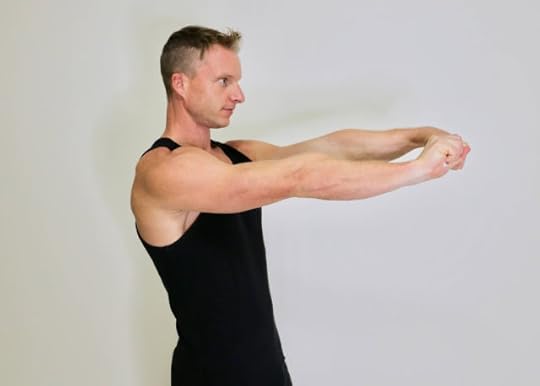
Slowly and with control, pretend you are wringing water out of the towel. Tilt one wrist up and the other wrist down at the same time, then alternate sides.

Continue wringing the towel in both directions for 10 full reps.
2) Dumbbell Wrist Curl | 10 reps per side
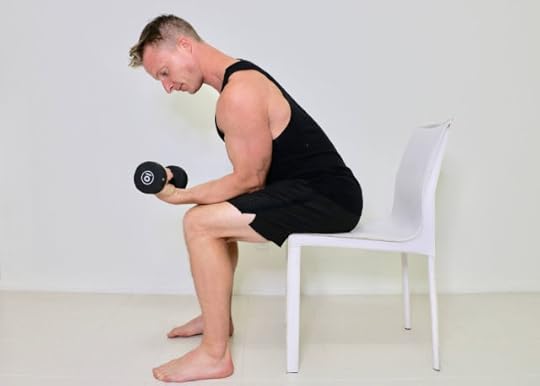
Sit on a chair or bench. Hold a light dumbbell in one hand and rest your elbow on your knee.
Keeping your arm still, exhale to flex your forearm and bend your wrist towards you to curl the dumbbell up.
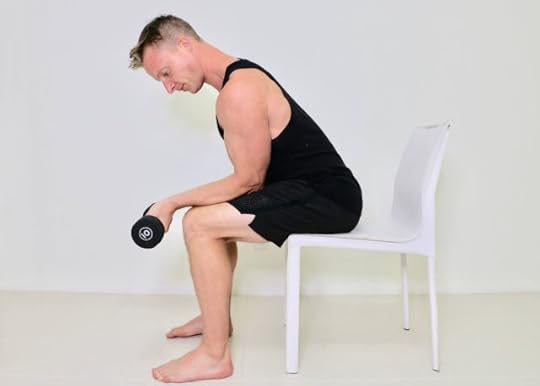
Inhale to relax your wrist back to the starting position. .
Repeat for 10 slow and controlled reps, focusing on full range of motion with your wrist. Then switch sides.
3) Elbow Compression with Small Towel | 3 reps per side

Hold your arm out long. Roll up a small towel and place it right over your elbow.
Make a fist and curl your arm towards you, bending your elbow all the way closed on the towel. Aim to reach your knuckles to your shoulder.
Use your other hand to gently press inward on the back of your wrist to increase the compression. Breathe deeply as you hold for five seconds, then switch sides.

Complete three reps per side.
4) Narrow Grip Wall Press Tricep Extension | 10 reps

Place your palms flat on the wall at your chest height.
Step back a few feet so your body is at a slight angle. Ensure that your palms are flush against the wall.
Bend your elbows to lower your body towards the wall, keeping your elbows pointing straight down.

Stop when your elbows are about 3 inches from the wall and press back to straighten arms, flexing your elbows all the way.
Continue for 10 reps.
Tip: For a greater challenge, you can try this exercise with palms on a bench.
5) Hip and Low Back Compression Stretch | 3 reps per side
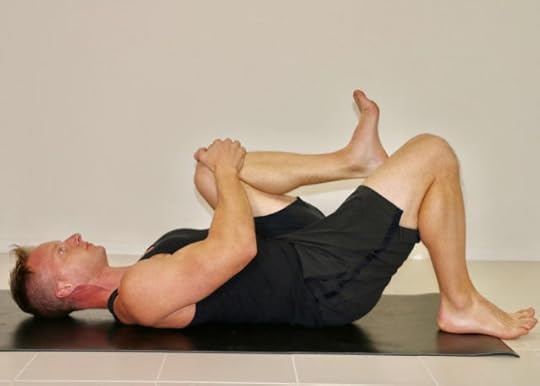
Lay flat on your back with your knees bent, feet flat on the ground.
Lift one knee towards your chest, using your hands to pull it in towards you. Actively work to ground your hips.
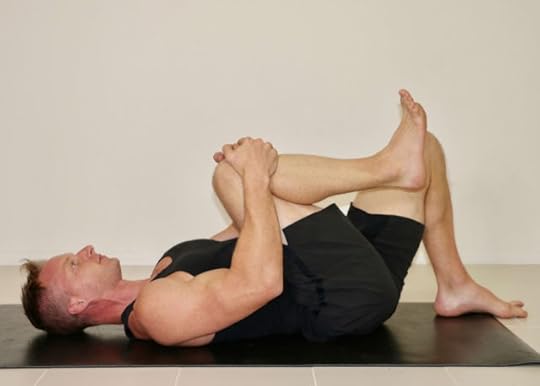
Take five deep breaths, then switch and do the same on the other side.
Continue alternating sides to complete three reps per side.
6) Pelvic Tilt | 10 reps

Stand with your feet shoulder-width apart.
Hinge at the hips and place your palms on your knees.
Lift your sitting bones and tilt your pelvis forward to create an arch in your lower back and stretch your hamstrings. Keep your neck in neutral and shoulders relaxed. Hold for a few breaths.

Next, round your lower spine and tuck your pelvis under to form a round shape. Hold for a few breaths.
Alternate between tilting forward and back for 10 reps, holding each pose as long as you like to relieve the pain and pressure in your low back and hips.
7) Single Leg Toe Touch | 10 reps per side
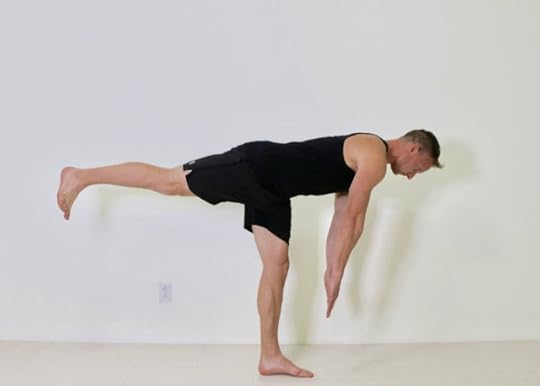
Stand on one foot and look down towards the ground to get balanced.
Hinge at the hips as you raise your back leg behind you, reaching your fingers toward the toes of the standing leg. Get as parallel to the ground as you can.

Slowly rise back up with control.
Repeat 10 reps on one side, then switch to the other side.
8) Glute Kicks | 10 reps

Kneel down on all fours and flex your right foot. Keep your left foot relaxed.
Lift your right leg up to form a straight line from your right knee to shoulders, with your right foot facing the ceiling.

Hold at the top for three seconds while engaging your glutes, then relax your knee back to the ground.
Repeat on the same side for 10 reps, then switch to the other side.
9) Resistance Band Knee Extension with a Chair | 10 reps per side
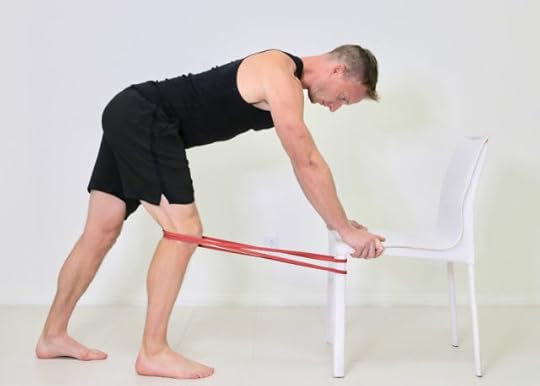
Loop a resistance band around one leg of a chair, and place the other end of the band behind one of your knees.
Grab the seat of the chair with your hands. Then step back until you feel a good amount of tension on the band.
Your banded leg should be directly below your hips.
Straighten your leg fully, resisting the tension on the band.
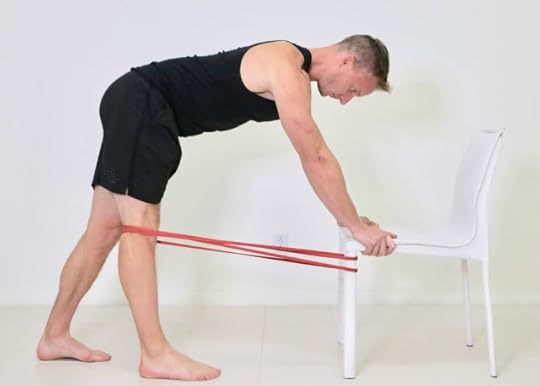
Then relax the knee. Keep your foot flat on the ground the entire time.
Repeat for 10 reps, then switch legs.
10) Isometric Quad Flex | 6 reps per side
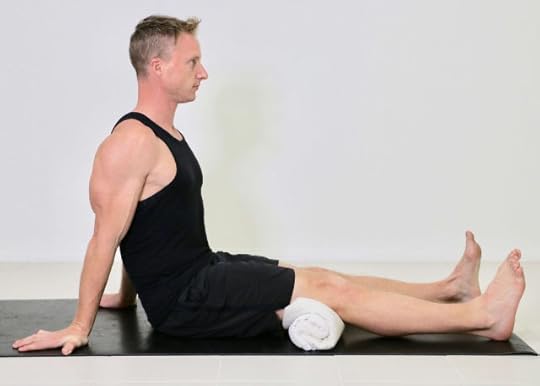
Sit on the ground and place a rolled up bath towel under your right knee.
Place your hands on the ground behind you for support and sit up tall.
Flex your right leg to lift your heel off the ground. You should feel all the muscles surrounding your knee fire up.
Hold this flex for five full seconds, then relax.

Repeat six times on this side, then switch to the left leg.
Tip: For a challenge, increase the number of reps or increase each hold to eight seconds.
Revisit these helpful exercises anytime you feel joint pain or discomfort. As always, be smart about working through an injury. If your body is telling you to rest, do it. When the time is right, apply these gentle exercises to help you get stronger and feel better.
Thanks again to Jessica Gouthro for these tips and to Brad Gouthro for demonstrating them. Questions or comments about exercises or treatment for joint pain? Share them below, and thanks for stopping by.

The post 10 Moves To Help Ease Joint Pain appeared first on Mark's Daily Apple.



Mark Sisson's Blog
- Mark Sisson's profile
- 199 followers




